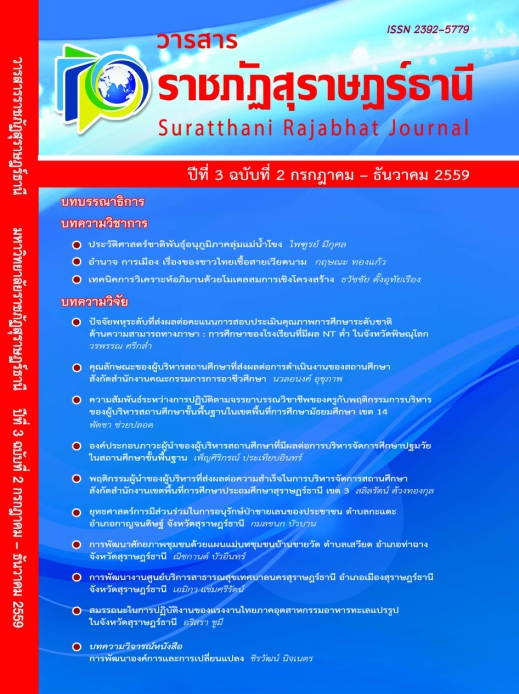The Development of Potential Community by the Community Master Plan of Ban Chay Wat, Sawiat Subdistrict, Tha Chang District, Surat Thani Province
Main Article Content
Abstract
This research aims to study the urban context, the development of potential community by the community master plan of Ban Chai Wat, Sawiat sub-district, Tha Chang District, Suratthani Province. This study employed an action research. The samplings are formal and informal community leaders, the residents in the community and state officials by using archival research tool through the community group chat as summarized below;
The study on the urban context and the potential of Ban Chai Wat Village found that the village was old and separated from Village No.2 and the houses were situated around the Wat Pratooyai, the locals called this village as Ban Chai Wat. Currently most farmers grew oil palm trees instead of rice fields due to poor productivity and lacking of water for agriculture. The overall economic was moderate. A group of female activists initiated batik fabric production, village fund and the Truth Group. However, most of the residents lacked knowledge for the careers, so they did not use their full capacity. Also, there was no recording of the household accounting while the health problems and the social problem for the youth involved with drugs resulting the lack of dependence and participation in the community and the lack of common sense in the local culture.
The development of the potential community with a master plan generated from the linkages of the thinking processes for the locals resulting a new vision for a solution by adhering to self-sufficiency. Previously, there was no communal corporation or even setting up of any self-communal development project. Not long after the presentation to the community on the importance of social and communal corporation, the working manual was written and distributed to the members as gridlines for the community to benefit all equally and they gathered and created the community economy. So they lived in harmony in the community as well as the management of natural resources that was once limited to the maximum and the know-how for the renewable resources resulting 20 projects proposals for the solution; 5 projects in Economy, 7 projects in Social and Culture, 5 projects in Political and Science and 3 projects in Environment..
Article Details
References
พนัส พฤกษ์สุนันท์, อุบล จันทร์เพชร และจินตนา ชุณหมุกดา. (2549). รายงานการวิจัยปฏิบัติการแบบมีส่วนร่วมของสมาชิกชุมชนเพื่อพัฒนาชุมชนน่าอยู่ : กรณีศึกษาจังหวัดราชบุรี. ราชบุรี : ศูนย์ส่งเสริมสุขภาพเขต 4 ราชบุรี กรมอนามัย กระทรวงสาธารณสุข.
วรางคณา วัฒโย. (2540). แนวทางการทำแผนพัฒนาชุมชนโดยวิธีการมีส่วนร่วมของประชาชน: กรณีศึกษาสุขาภิบาลเจาเจ็ด จังหวัดพระนครศรีอยุธยา. วิทยานิพนธสถาปตยศาสตรมหาบัณฑิต สาขาวิชาการผังเมือง บัณฑิตวิทยาลัยจุฬาลงกรณ์มหาวิทยาลัย.
ศูนย์วิชาการด้านยาเสพติด. (2558). แก้ไขปัญหายาเสพติดด้วยพลังชุมชน. สำนักคณะกรรมการป้องกันและปราบปรามยาเสพติด. (Online) สืบค้นได้จาก : http://nctc.oncb.go.th/new/index.php?option=com_content&view=article&id=1072:2555-02-10-07-m-s&catid=239:all-content&Itemid=270. [2558, มกราคม 8].
เสรี พงศ์พิศ. (2550). เศรษฐกิจพอเพียง การพัฒนายั่งยืน. กรุงเทพฯ : พลังปัญญา.


